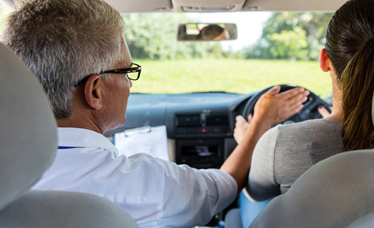Chapter 12 – Section 1
Mandatory Vehicle Equipment
Traffic laws need to be respected. Know the rules and guidelines before you drive. The laws and rules of the road should not be afterthoughts; they should be learned and observed.
A. Lights
The lights on a motor vehicle are essential to safe driving. The following laws and requirements apply:
- The law requires you to use your headlights from half an hour after sunset to half an hour before sunrise. Additionally, you must turn on your headlights anytime you cannot see at least 500 feet ahead.1
- You must also use your headlights when: it is cloudy, raining, snowing, or foggy; when windows are icy; or when you use your windshield wipers. These conditions make it difficult to see other cars, so you need to turn on your lights to help you see better and to increase your vehicle’s visibility to others.
- Headlights should be used during the daytime when you are driving on mountain or country roads, through canyons or tunnels, or at any other time you have difficulty seeing.
- It is illegal to drive with only your parking lights on when you are required to use your headlights.
- High beams are for driving in open country when no traffic is in sight. Theycan momentarily blind other drivers so you may use them only when there is no direct negative impact on any other drivers.
- Headlights must be on low beam when another vehicle is approaching or when driving behind another vehicle.
- Taillights need to be maintained because they make your vehicle visible to drivers behind you.
- Use emergency hazard lights or flashers only in distress situations to alert other drivers of a problem. These lights are the same ones used as brake lights, and a switch or button inside the car activates them. When activated, they flash at regular intervals until turned off. These flashing red lights warn other drivers that there is a problem with your vehicle and that they should use extra caution near it.
- Any vehicle may have two additional auxiliary lamps (such as fog, passing, or driving lamps).
- When you drive in reverse, your vehicle’s backup lights come on. These must be checked to make sure they are in working order. It is against the law to have any backup lights on while a vehicle is moving forward.2
B. Horns
The horn should be used as a communication tool to warn other drivers of possible hazards. The horn needs to be in good working order, capable of emitting sound that can be heard at least 200 feet away.3 Unfortunately, use of the horn sometimes incites road rage situations. Animals use horns to establish dominance and to protect against predators. However, do not be afraid to use your horn; it can save lives. As a warning mechanism, there is nothing more effective in your vehicle. Follow these guidelines on when to use the horn:
- As a rule, the horn should be used only in emergency or distress situations.
- The horn should be used any time it is necessary to avoid a collision.
- Do not use your horn to attract the attention of other drivers unless it is necessary to avoid a collision or for the safe operation of your vehicle.
- When driving on a mountain road where visibility is impaired and you cannot see at least 200feet ahead, you should sound the vehicle’s horn to warn other drivers of your vehicle’s presence.
- If the roadway is not wide enough and you are approaching a curve with an unobstructed view of less than 200 feet, you should use the horn to warn other drivers of your presence.
- It is a good idea to use the horn as an additional signal when passing or when coming out of a blind alley, curve or driveway.4
C. Brake Lights
Your vehicle’s brake lights warn the drivers behind you that you are stopping. Brake lights must be functional and properly maintained as they are an essential part of safe driving. The drivers behind you need to have ample warning when you slow down or stop. Missing or in operative brake lights often lead to rear-end collisions since the drivers behind are unable to tell when the vehicle ahead is slowing down. Tailgating is a major problem on the roads today, and brake lights that are not functioning properly add to the danger. It is nearly impossible to judge whether a vehicle is slowing down if the brake lights do not work. Periodically checking and replacing the vehicle’s brake lights solves this problem.
Note: All new cars manufactured since 1986 must have a third rear brake light mounted on the rear window.
D. Signaling/Turn Signals
Always signal to let other drivers know of your intention to turn or change lanes. Men and women often get their signals crossed. Also watch for other drivers’ signals at all times. Turn signals are located next to the headlights on the front and next to the brake lights on the rear of the vehicle. They let other drivers know you intend to turn or change lanes. To signal, simply move the lever (which is connected to the steering wheel) up for a right turn signal or down for a left turn signal. Important tips to remember include:
- Signal before pulling towards or away from the curb.
- Signal before changing lanes.
- Always use arm signals if other drivers cannot see your signal lamps (such as during daytime hours if it is very bright outside).
- Signal during the last 100 feet before turning and make sure the turn signal is cancelled after you complete the turn.5 On the highway, it is best to signal at least five seconds before changing lanes.
- Signal to warn other drivers of a collision ahead.
- Use brake lights to signal your intention to stop or brake quickly.
1 New Jersey Statute 39:3-46
2New Jersey Statute 39:3-52
3New Jersey Statute 39:3-69
4The New Jersey Motor Vehicle Commission. (February 2011). The New Jersey Driver Manual. Page 43. Retrieved from http://www.state.nj.us/mvc/pdf/Manuals/drivermanual.pdf
5New Jersey Statute 39:4-126















